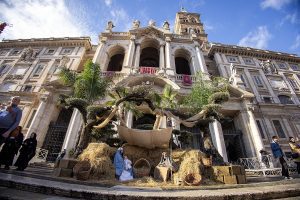PARIS (OSV News) – Firefighters and police officers formed a human chain to rescue the crown of thorns from the inferno at Notre Dame on April 15, 2019. On Dec. 13, 2024, this holiest relic of Paris’ cathedral was returned to its proper home on the Île de la Cité.
Though temperatures were cold, the facade of Notre Dame was sunny in the late afternoon, as the procession arrived on foot along the cathedral from Palais du Louvre, on the other side of the Seine River, where the treasure had been stored since the fire.

A knight of the Equestrian Order of the Holy Sepulchre of Jerusalem, dressed in a large black cloak trimmed in red, held the crown of thorns, in its crystal circle frame, on a red velvet cushion. Over 400 members of the Order of the Holy Sepulcher, including 200 knights dressed in white coats marked with the red Jerusalem cross, participated in the procession. They have been the crown’s honor guard since the archbishop of Paris entrusted it to their care in 1923.
The crown of thorns, placed on Jesus’ head by his captors to cause him pain and mock his claim of authority, was acquired by St. Louis, then-King Louis IX of France, in Constantinople in 1239 for 135,000 livres — nearly half France’s annual expenditure at the time, according to the BBC.
It was moved to Notre Dame’s treasury from the magnificent Sainte-Chapelle in 1806.
A crowd of faithful and curious onlookers gathered on the forecourt of the cathedral as the relic made its way to Notre Dame. Among them was Bénédicte de Villers, a 50-year-old woman who had come to do some Christmas shopping in central Paris. “I was not far away, and realizing what was happening, I took the Metro to come,” she told OSV News.
“I arrived in front of Notre Dame just as the procession was beginning to enter the cathedral through the central door. Hearing the organ and the singing, I begged the security guards to let me in, explaining that I am a practicing Catholic, and that praying in front of Christ’s crown of thorns meant a lot to me,” she said. “I had already come to venerate it at Notre Dame during Lent.”
The lucky onlooker said that the guards let her in, and she was able to witness the ceremony from up close.
Once the crown of thorns had been placed on the main new altar inside the cathedral, Archbishop Laurent Ulrich of Paris addressed the 2,000-strong audience of faithful.
“We are moving from the time of Advent to the time of the Passion, but that is the way it is all the time in life, and in the Christian life,” he said. “We come to adore the Lord in the gift he made of himself to all humanity, as the Son of God.”
During the Passion reading that followed, the cathedral’s rector-archpriest, Father Olivier Ribadeau Dumas, presented the crown to the faithful in a long, deep silence.
The procession of chaplains, canons and knights then made a complete tour of the cathedral through the side aisles, with the crown of thorns, while the choir sang the Litany of the Passion.
“It was a very slow, very contemplative tour, so that everyone could see the crown (of thorns),” Villiers recounted. “Everyone was silent, very respectful … It was a solemn but joyful ceremony, with everyone in awe of the cathedral’s beauty,” she said.
Night had fallen by the time the procession reached the back chapel behind the choir, in the axis of the nave. Here, under a vault in which the blue color has been revived, the new reliquary of the crown of thorns has been placed.
It is the work of French designer Sylvain Dubuisson, and takes the form of an altarpiece in marble and cedar wood, with the altar wall 12 feet high and 10 feet wide. It evokes the iconostasis of Orthodox churches with its notched panels enclosing gilded bronze thorns. This serves as a reminder of the history of the crown of thorns. For several centuries, before St. Louis purchased it, it belonged to the Byzantine Empire.
The marble altar is lit by small candles, and the central part of the cedar wall is a gilded disk, adorned with 396 hand-crafted glass blocks that reflect the light. At its center, some 7 feet high, a blue niche, matching the chapel’s vaulting and stained-glass windows, shelters the crown of thorns.
Archbishop Ulrich blessed the new reliquary, and prayed for all those who will come to pray there.
Father Pascal Ide, one of the cathedral’s chaplains, told OSV News he was mesmerized with the new design. “This new reliquary is all radiance,” he said.
The relic of the crown of thorns will be displayed every Friday from Jan. 10, 2025, until Good Friday; on other days it will be stored in the safe inside the marble altar.
For Father Ide, Notre Dame is now entirely a “cathedral of light.”
“Reopening day was a historic moment,” he said. “I spent three hours discovering it (anew), and prayed in each of its 29 side chapels. The physical path around it is like a mystical itinerary, which allows you to inscribe your personal story in the great story of salvation.”










